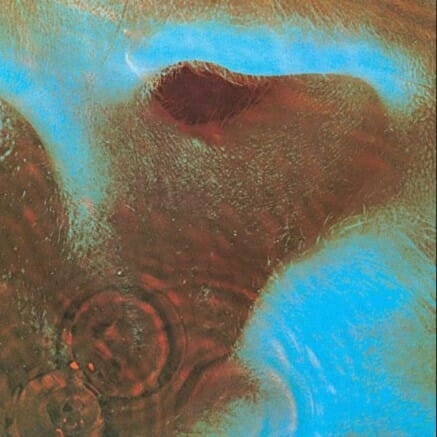It’s undeniable that Pink Floyd, the legendary purveyors of psychedelic rock, have secured their status in the halls of music history with their unparalleled, ethereal soundscapes.
However, this focus on their sonic artistry sometimes overshadows another critical facet of their legacy: their hypnotic and genre-defining album cover art, which has proven to be equally impactful and enduring.
Each Pink Floyd album cover serves not just as a decorative sleeve, but as a vibrant portal to the musical universe within. These masterpieces of visual design transcend the conventional role of album art, offering an immersive aesthetic experience that harmonizes with the band’s groundbreaking music.
Every cover represents a unique creative endeavor, with its intricate details and striking symbolism offering an exciting preview of the psychedelic journey that awaits within the album’s grooves.
In this article, we’ll embark on an exploration of the stunning visual chronicles that are Pink Floyd’s album covers. We will take you on a journey through the band’s discography, presenting each album in chronological order.
Prepare to delve deep into this captivating journey, uncovering the nuances and meanings behind each mesmerizing piece of art. By the end, you will gain a profound appreciation for how Pink Floyd, through their iconic album covers, profoundly redefined the landscape of musical aesthetics.
The Piper at the Gates of Dawn, 1967
Design: Vic Singh

The debut album, “The Piper at the Gates of Dawn”, laid the foundation for the future of Pink Floyd. As the opening scene of a long, profound journey, the cover encapsulates the band’s initial identity and aspirations.
Vic Singh’s prismatic shot of the band members, resulting from an infrared lens and a simple prism, teases the experimental and mind-bending nature of the music contained within. The luminescent colors and kaleidoscopic vibe hint at the psychedelic rock that characterizes the era, while also inviting listeners to experience the world from a new, unconventional perspective.
A Saucerful of Secrets, 1968
Design: Hipgnosis (Storm Thorgerson and Aubrey Powell)

Moving on to “A Saucerful of Secrets”, the cover signifies a shift in their visual approach. The cover, a celestial smorgasbord of color and textures, appears to mirror the universe’s chaotic harmony, reflecting the experimental and ethereal nature of the tracks within.
Hipgnosis, a design group that would soon become synonymous with Pink Floyd’s image, took charge. The variegated elements, teeming with stars, planets, and celestial bodies, embody the groundbreaking sounds, illuminating the band’s pursuit of expanding the boundaries of rock music.
RELATED: The Very Best Pink Floyd Songs
More, 1969
Design: Hipgnosis (Storm Thorgerson and Aubrey Powell)

In 1969, Pink Floyd released More, their third studio album and first film soundtrack. The album cover, designed by Hipgnosis, takes a noticeably stark approach compared to their earlier albums. It features a film still of two characters amidst the heat of the Ibiza sun, an image directly linked to the film for which the album serves as a soundtrack.
The bare-bones aesthetic of the cover is a departure from the vibrant psychedelia of their earlier album art, echoing the stripped-down nature of the music within. More contains some of Pink Floyd’s most minimalist compositions, the band having been tasked with creating a soundtrack that would not overshadow the film. The starkness of the cover image reflects this raw, bare soundscape.
The cover’s photo, with its stark contrast and gritty realism, serves as an interesting juxtaposition to the band’s previous aesthetic. The film was processed in a dark room, giving it the appearance of a psychedelic trip.
Ummagumma, 1969
Design: Hipgnosis (Storm Thorgerson and Aubrey Powell)

“Ummagumma” merges the real with the surreal, taking listeners on a trip down the rabbit hole. The cover art presents an endless visual echo, the band members nested within themselves in an infinite regression.
This illusion of infinity, designed by Hipgnosis, mirrors the experimental duality of the album, which was part live recordings and part solo efforts from each band member. It presents a paradoxical, immersive experience, the cover art drawing you into the depths of Pink Floyd’s artistic universe.
RELATED: Is Richard Wright The Overlooked Member Of Pink Floyd?
Atom Heart Mother, 1970
Design: Hipgnosis (Storm Thorgerson and Aubrey Powell)

Venturing into the new decade, Pink Floyd unveiled a radically different and unexpectedly peculiar album cover with Atom Heart Mother. Breaking away from the psychedelic motifs and band portraits that were in vogue during the late 60s, the cover image is deceptively simple – a single, black-and-white photograph of a cow standing idly in a field, taken by Storm Thorgerson of the design group Hipgnosis.
This cover came about from Thorgerson’s desire to “do something as mundane and as ordinary as possible”. A far cry from the mind-bending aesthetic of their previous album covers, the serene image of the cow offers no obvious clues to the experimental music contained within the vinyl sleeve. Yet, it’s exactly this non-sequitur presentation that makes it intriguing.
Meddle, 1971
Design: Hipgnosis (Storm Thorgerson and Aubrey Powell)

Crafted by the talented Storm Thorgerson, the cover of ‘Meddle’ showcases a striking close-up of an ear submerged underwater, being exposed to an echo sonar. In its simplicity, the artwork holds a remarkable power, effectively conveying the album’s bold exploration of uncharted sonic landscapes.
Thorgerson’s design succeeds in drawing the viewer in, inviting them to partake in a truly profound auditory experience. The image serves as a visual metaphor, symbolizing the receptive nature of the listener and the transformative impact of the music. The gentle ripples created by the sonar waves add an element of intrigue and anticipation, hinting at the mesmerizing journey that awaits within the album.
Through careful attention to detail, the cover art encapsulates the immersive quality of the music itself. It ignites the imagination and evokes a sense of wonder, capturing the essence of Pink Floyd’s distinct sound. The ear underwater becomes a portal, beckoning the listener to dive deep into the progressive and psychedelic rock realms that “Meddle” masterfully explores.
RELATED: We Rank Pink Floyd’s Best Albums
Obscured by Clouds, 1972
Design: Hipgnosis (Storm Thorgerson and Aubrey Powell)

Pink Floyd’s “Obscured by Clouds” is encapsulated perfectly by its enigmatic cover art. The visual comprises a distorted, refracted image as if viewed through a textured glass panel. This provides an abstract and elusive view, much like the fleeting, dreamlike quality of the music within.
The album, serving as a soundtrack to Barbet Schroeder’s film “La Vallée,” embraces obscurity and clouded perceptions, a theme reflected beautifully in the intriguing design of the cover.
The Dark Side of the Moon, 1973
Design: Hipgnosis and George Hardie

“The Dark Side of the Moon” features one of the most iconic album covers of all time. It showcases a simple prism refracting white light into a rainbow against a stark, black background – a striking visual metaphor for the thematic depth and breadth of the album.
This cover, another masterpiece by Hipgnosis, aligns with the album’s exploration of life, time, greed, and mental health. As simple as it is significant, the cover perfectly encapsulates Pink Floyd’s music’s transformative and boundary-pushing nature.
The design team was initially inspired by the image of a triangular glass paperweight in a French physics textbook, and the band loved it immediately. Aubrey Powell commissioned illustrator George Hardie to create the illustration, and the rest is album art history.
RELATED: The Best Of Motley Crue’s Iconic Album Art
Wish You Were Here, 1975
Design: Hipgnosis (Aubrey Powell)

“Wish You Were Here,” a commentary on the alienation and emotional void left by the band’s former frontman Syd Barrett, delivers one of Pink Floyd’s most poignant covers. It features the surreal image of two men shaking hands, one of whom is on fire.
This captures the essence of the music within – a searing critique of the music industry that had ‘burnt’ them in the past. This unforgettable image, shot by Storm Thorgerson, is a powerful visual metaphor for sacrifice and loss, adding another layer to the music’s emotional resonance.
To achieve the right amount of authenticity for the image, Storm Thorgerson hired stuntman Ronnie Rondell to be set on fire for the shoot. Tragedy was narrowly avoided after the wind changed suddenly and blew the fire directly into Ronnie’s face. Luckily there were no lasting injuries and the image went on to be one of the band’s most iconic and memorable a, album covers.
Animals, 1977
Design:

“Animals” manifests Pink Floyd’s critique of capitalist society in its cover art. The iconic image of a pig floating between the chimneys of Battersea Power Station is not only a startling visual but a symbolic critique of societal hierarchies and political corruption.
This cover, photographed by Carinthia West and conceptualized by Roger Waters, reflects the album’s exploration of the darker undercurrents of human society, making it one of Pink Floyd’s most politically charged albums.
Famously the shoot was filled with mishaps and adventures, several times Algie (the 40-foot helium-filled pig) broke her mooring lines and drifted away, interrupting flights at Heathrow Airport, and giving some cows a fright in a field in Kent.
When the perfect shot was finally taken on day 3, the weather was too sunny to suit the mood of the cover, so the final image was a hybrid of the last photo of Algie, and an earlier shot of Battersea Power Station, with a more ominous looking and cloudy background.
RELATED: The Pink Floyd Story
The Wall, 1979
Design: Gerald Scarfe

“The Wall” is a landmark album in Pink Floyd’s discography for its exploration of isolation, madness, and the human condition. Its cover design, a stark and blank brick wall, is simplicity at its most profound.
Created by English cartoonist Gerald Scarfe, the cover conveys the album’s overarching theme of emotional barricades and isolation, while also hinting at the dramatic, rock opera narrative housed within.
The text was hand-scribbled by Scarfe in a hurry, and initially, they fought to not include a logo on the cover. Worried that no one would know who the album was by, they conceded and printed the logo on a separate piece of cellophane within the inner sleeve. Once you took the record home and opened it, the logo would fall out, leaving you with the pristine white wall of bricks.
It is a masterclass in minimalistic design, demonstrating how less can indeed express so much more.
The Final Cut, 1983
Design: Roger Waters and Artful Dodgers (Willie Christie)

“The Final Cut” cover carries forward the war motif from “The Wall”. The Remembrance Day poppies, a universal symbol of military sacrifice, dominate the foreground. Yet, amidst the sea of red flowers, a solitary black poppy stands out – an unspoken homage to the ‘lost generation’ affected by the aftermath of war.
The cover is a poignant visual interpretation of the album’s theme, highlighting the band’s critique of war and its unnecessary human cost.
RELATED: Check Out Hipgnosis’ Work On Led Zeppelins Most Famous Album Covers
A Momentary Lapse of Reason, 1987
Design: Hipgnosis (Storm Thorgerson)

With “A Momentary Lapse of Reason,” Pink Floyd embraced surrealistic imagery. Hundreds of wrought-iron hospital beds were arranged along the shoreline for the cover shoot, embodying themes of alienation and insanity.
Conceived by Storm Thorgerson, the scene evokes a sense of unease, mirroring the album’s exploration of distorted reality and disturbed mental states. This visual spectacle showcased Pink Floyd’s commitment to thematic consistency, even in the absence of founding member Roger Waters.
The Division Bell, 1994
Design: Storm Thorgerson, Keith Breeden, and John Robertson

“The Division Bell” marked Pink Floyd’s final album with original members and it fittingly went for a more abstract cover design. The artwork features two large, face-like steel sculptures, representing conversation and division, against a stark blue sky.
Created by Keith Breeden, the cover is open to interpretation, just like the album’s music. Its ambiguous imagery encourages introspection and echoes the themes of communication, division, and the passage of time present in the songs.
The Endless River, 2014
Design: Aubrey Powell, Ahmed Emed Eldin

“The Endless River,” Pink Floyd’s last studio album, acknowledges the passing of the legendary Storm Thorgerson with a peaceful yet powerful cover. A man is seen rowing a skiff on a river of clouds, towards the sun.
The cover, designed by 18-year-old Ahmed Emad Eldin and selected by Hipgnosis’ Aubrey Powell, blends the band’s past and present. It evokes a sense of closure and endless journey, underlining the band’s enduring legacy and the eternal flow of their music.
Looking Beyond the Cover
Pink Floyd’s album covers are more than just packaging; they are an integral part of the band’s artistic identity. Each album cover is a gateway into the themes and soundscapes that Pink Floyd explored, inviting listeners on a journey beyond the realm of music into the universe of visual metaphor and symbolism.
In the world of streaming and digital downloads, these covers remind us of the immersive, tactile experience of physically holding an album, appreciating the art, and diving into the music. From “The Piper at the Gates of Dawn” to “The Endless River”, the Pink Floyd album covers are an essential part of the band’s legacy, a visual odyssey as profound and iconic as the music itself.
Through their album covers, Pink Floyd didn’t just change the way we listen to music; they transformed the way we see it.
If you want to learn more about the dynamic duo that was Hipgnosis, check out the trailer for the upcoming film, ‘Squaring The Circle – The Story Of Hipgnosis’, the creative team behind some of rocks most iconic album covers.
- The 25 Richest Rock Stars in the World | A Rock And Roll Rich List - February 22, 2024
- Rock And Roll Movies | 20 Films That Will Rock Your World - February 19, 2024
- The Biggest One Hit Wonders In Rock History - February 16, 2024


